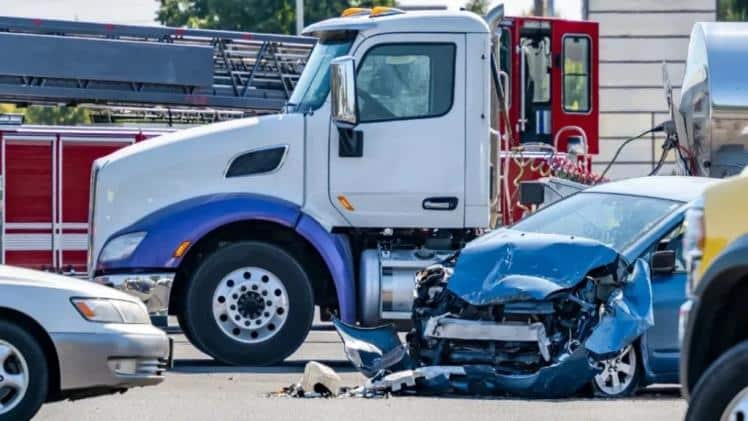How to Prove Negligence in Commercial Vehicle Accident Claims

Understanding Negligence in Commercial Vehicle Accidents
Commercial vehicle accidents can have devastating consequences for victims, often involving severe injuries or significant property damage, and are especially overwhelming when they involve massive semi trucks or company vehicles. These collisions are not only physically dangerous but potentially financially ruinous, given the high costs of medical care, vehicle repair or replacement, and missed income due to time away from work. When a crash occurs with a large truck or any commercial vehicle, the road to recovery can be complex—especially when seeking legal compensation for your losses. This is where a solid grasp of negligence comes into play, as it forms the foundation for all injury claims. Legally speaking, negligence arises when an individual or entity fails to exercise the degree of care that a reasonable, prudent person would exercise under similar conditions, and that lack of care harms someone else. Because commercial accidents often involve multiple parties, layered regulations, and insurance complications, consulting an experienced semi truck accident attorney is strongly advised. These professionals can help guide accident victims through the layers of state and federal law that shape liability in these cases, ensuring their right to compensation is properly protected.
For accident victims, proving negligence is about demonstrating that the responsible party did not act with the reasonable care required under the circumstances. This can mean showing that a driver was distracted, a company cut corners on maintenance, or that safety rules were systematically ignored. Establishing negligence relies on fact-finding—through a systematic review of the events leading up to the crash, analysis of the driver’s actions, and whether the commercial carrier followed industry-standard safety and training protocols. By gathering clear evidence of carelessness or rule-breaking at any point in the chain of responsibility, injured parties can strengthen their case and position themselves to recover monetary damages for every category of loss they have sustained.
Key Elements to Establish Negligence
Successfully proving negligence in a commercial vehicle accident claim requires establishing four essential elements recognized by courts and insurance companies. These elements form the legal test for negligence:
- Duty of Care: The at-fault driver or commercial operator owed a duty to those around them to operate their vehicle reasonably safely and comply with all traffic laws, federal trucking regulations, and industry standards to avoid unnecessarily endangering others.
- Breach of Duty: There must be clear evidence that this duty was breached. Examples of a breach include reckless driving, speeding, distracted or impaired driving, ignoring required rest breaks, failing to maintain the vehicle in safe operating condition, or other failures to follow safety protocols to protect the public.
- Causation: The plaintiff—the person seeking compensation—must establish a direct link between the defendant’s breach of duty and the accident. This means showing not just that carelessness occurred, but that it actually caused or significantly contributed to the resulting injuries or damage, rather than being a coincidental or unrelated error.
- Damages: The incident must have caused actual harm or measurable losses, such as medical bills, lost wages, property damage, pain and suffering, or other consequences recognized under state personal injury law.
Meeting all four standards is necessary to show that the defendant’s actions (or lack thereof) were both careless and directly responsible for the harm suffered by the claimant. If even one element is missing, the injured party’s chances of a successful claim decrease dramatically.
Gathering Crucial Evidence
The strength of a negligence claim depends heavily on the quality and depth of the evidence collected in the aftermath of the accident. Proving liability in a commercial vehicle accident requires much more than a mere police report; it often involves sifting through a complex array of records and documentation that can paint a full picture of exactly what went wrong. In most cases, accident victims must act quickly to preserve evidence and build an effective claim, especially since trucking companies and insurers may begin their investigations immediately. Here are some of the most important types of evidence to gather:
- Police Reports: These provide a third-party account of the accident, often documenting witness names, physical evidence, contributing factors, and citations issued at the scene. Police findings can support an injured party’s version of events and may offer insight into the likely cause of the crash.
- Witness Statements: Statements from people who saw the accident are important to corroborate your claims, add perspective, and address uncertainties or disputes over what happened. Independent witnesses can often neutralize conflicting stories by providing unbiased testimony.
- Electronic Logging Device (ELD) Data: Modern commercial vehicles are legally required to use electronic logging devices that automatically record driving hours, breaks, and routes. ELD data can reveal violations of regulations regarding driver fatigue and hours of service, providing powerful evidence if overtired driving contributed to the collision.
- Maintenance Records: Trucks, buses, and vans that transport goods or passengers are held to rigorous maintenance standards. Documentation showing skipped inspections, deferred repairs, or shoddy work can indicate the vehicle’s owner or operator was negligent about safety.
- Driver’s Employment Records: The operator’s background, training history, and driving record can reveal whether the company hired someone with a checkered past or past violations or whether a lack of training or supervision contributed to unsafe operation.
Taking proactive steps to recover and safeguard key records—sometimes with the help of a lawyer—can make the difference between success and failure in a negligence claim.
Identifying Potentially Liable Parties
Commercial vehicle accidents can involve a surprisingly complex web of potentially responsible parties. In many claims, it is not only the driver who may be held accountable; accident victims and their lawyers must identify everyone whose conduct or decisions may have played a key role. Responsible parties can include:
- Truck Drivers: They may be held accountable for their actions, such as distracted or impaired driving, speeding, violating hours-of-service rules, or other unsafe behaviors behind the wheel, particularly if these choices were the primary cause of the accident.
- Trucking Companies: Carriers are responsible for hiring qualified drivers, enforcing safety regulations, conducting proper training, and maintaining equipment. They can be liable if they cut corners to save money, fail to supervise their employees, or allow dangerous practices to become routine.
- Vehicle Manufacturers: In the event of a defect—such as faulty brakes or a tire blowout—the company that built the truck or supplied a part may face legal responsibility under state and federal product liability laws.
- Maintenance Providers: Third-party mechanics, service companies, or fleet maintenance providers can also share blame if they skipped required work, used inadequate parts, or performed substandard repairs that contributed to the vehicle’s failure on the road.
- Cargo Loaders: Companies or individuals responsible for loading a truck can be found negligent if shifting or unsecured cargo caused the accident, especially in cases where proper safety procedures were ignored.
Utilizing Expert Testimonies
Expert witnesses are often an essential part of strong commercial vehicle accident claims. Because these cases involve complex technical, medical, and financial questions, expert testimony can help judges and juries understand precisely what happened, why the crash occurred, and how it affected the victim. Here are some common types of experts used in these cases:
- Accident Reconstructionists: These specialists use math, physics, vehicle data, and environmental evidence to recreate the crash and show how it unfolded. By piecing together movement patterns, speeds, impact angles, and other forces, they can illustrate who was at fault and why basic safety standards may have been violated.
- Medical Experts: Physicians, surgeons, or rehab specialists testify about the seriousness and cause of the victim’s injuries, their prognosis, necessary treatments, and how their physical, emotional, or cognitive functioning has been changed for the long term.
- Economic Experts: Financial specialists analyze the impact of the injury on the victim’s earning capacity, lost benefits, necessary medical and home care, and other quantifiable losses. Their input can help accurately determine the value of both current and future compensation.
Understanding Comparative Negligence
In commercial vehicle accident litigation, many states follow comparative negligence rules. Under this principle, everyone’s degree of fault is evaluated and assigned a percentage. Their percentage of fault then reduces the amount of damages awarded to the injury victim who caused the accident. For instance, if the court finds the injured person was 20% to blame and the truck driver 80%, any financial award to the victim will fall by 20%. In a strict comparative negligence state, even partial responsibility can sharply diminish or, in rare cases, eliminate eligibility for compensation. Knowing your state’s approach to shared fault is important, as it affects settlement strategies and the likely outcome in court.
Statute of Limitations
Every state enforces time limits for filing negligence lawsuits, known as statutes of limitations. These deadlines generally range from one to several years, depending on where the accident happened and whether property damage, bodily injury, or wrongful death is involved. Missing a statute of limitations almost always means the loss of your legal right to recover damages, no matter how strong your claim is. Therefore, it’s crucial to talk to an attorney and begin the process of evidence gathering and claim preparation soon after a commercial vehicle accident, before critical evidence is lost or destroyed.
Final Thoughts
Bringing a successful commercial vehicle accident claim is rarely simple. It demands a meticulous understanding of legal duties, careful evidence gathering, prompt identification of potentially liable parties, and thorough presentation of facts—often with the support of expert witnesses. By fully understanding and documenting the key elements of duty, breach, causation, and damages, accident victims equip themselves with the strongest possible foundation for fair recovery, whether through negotiation or litigation. Acting quickly and enlisting expert guidance ensures that your rights are preserved and your path toward compensation is as smooth and effective as possible.



